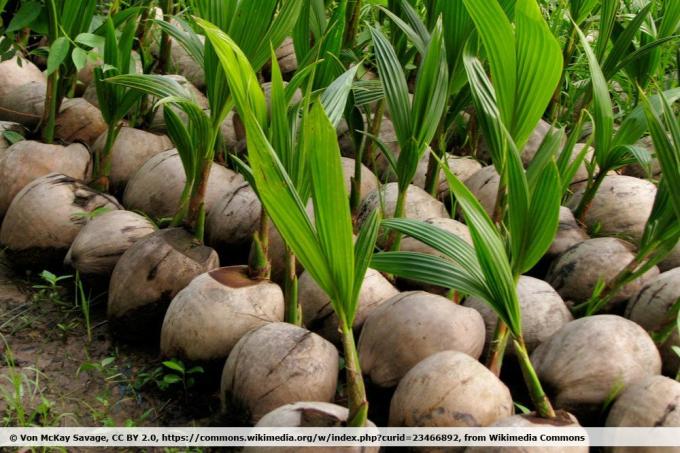
table of contents
- causes
- Nutritional deficiency
- Damaged roots
- humidity
- Lack of water
- Lighting conditions
- Temperatures
- Fertilize
- Compacted substrate
- Stunted growth
In Central Europe, coconut trees are mostly grown in pots because they cannot survive cold winters outdoors. It is one of the most popular exotic plants, as it hardly conjures up that South Sea feeling like any other palm tree in gardens, living rooms and on balconies. But often brown leaves are formed, which make for an unsightly sight. The reasons for this can be based on different factors. This has to be found out in order to ideally prevent it from dying off.
causes
Nutritional deficiency
A Cocos nucifera is grown from a coconut. If the roots multiply rapidly, a pot / tub will quickly become too small. The nutritional requirements of coconut palms can no longer be adequately met and the leaves react with a brown color. At the latest when roots grow out of the drainage hole at the bottom of the pot, it is time to transplant into a larger bucket / pot with fresh, nutrient-rich substrate.
Damaged roots
Roots can be damaged quickly when transplanting / repotting. These are often the reason when a Cocos nucifera turns brown shortly after purchase. Especially in mass productions, they are occasionally repotted carelessly into sales pots, with roots breaking off or tearing. This is how it comes to Supply disruptions and the leaves react with a brown leaf color. It is helpful to carefully lift the root out of the earth and shorten it altogether. While this will slow growth and make it continue to weaken initially, the chances are good that it will recover.
humidity
Coconut palms need a relatively high level of humidity for healthy, vigorous growth. Ideally, this is over 70 percent. If the humidity does not reach this value, the risk of the leaves turning brown increases as the humidity level decreases. The following measures solve the problem:
- Cut off the brown leaf
- Spray the palm daily, especially at high temperatures and low humidity, with lime-free water
- Keep the soil / substrate slightly moist at all times
- Never let the soil dry out
- If necessary, move to a damp location, such as the bathroom
Lack of water
In addition to high humidity, incorrect watering can also lead to brown leaves, which is caused by too little watering, while too much watering makes the foliage yellow. When watering, it is important to ensure that the soil is kept evenly moist without closing the palm oozing or Waterlogging to provoke. The best time to pour is easy to determine with the thumb test:
- The surface of the earth can be pressed in more than two centimeters with the thumb: do not pour
- The surface of the earth can be depressed less than two centimeters with the thumb: time to water
tip: Coconut palms are used to heavy downpours from their countries of origin as well as long dry periods. For this reason, they should rather be watered less, but vigorously, than more often with small amounts.
Lighting conditions
The Cocos nucifera needs a lot of light to thrive. If it is missing, it reacts with a brown color of the leaves and drying. In this case, the coconut palm must be moved immediately to a location where it can receive plenty of sun for a few hours. Twelve hours of full light are appropriate even in winter. If gray rainy days last longer, a plant lamp provides compensation.
Temperatures
A coconut palm should never be colder than 20 ° C. She likes best Full sun and the warmth associated with it. Cold drafts and cool winds can quickly turn the foliage brown. It is therefore important to ensure that it is kept in a warm location and that it spends the winter in a heated room. A winter garden offers a Cocos nucifera optimal location conditions, as long as it is at least 20 ° C.
Fertilize
Especially when temperatures are 27 ° C and more, the supply through the roots runs at full speed. In potted plants in particular, the nutrients in the soil are quickly used up. Fertilization is therefore essential. If this does not happen, brown spots usually form on the leaves of the coconut palm. If these have already arisen, they must be cut off. The administration of a vital and nutrient-rich fertilizer compensates for the missing nutrients in the soil and the palm continues to grow healthily in a strong green tone. For prevention should adhere to the following Fertilization plan being held:
- Apply nutrient fertilizers every two weeks from spring to autumn (April to September)
- Strictly adhere to the manufacturer's recommended dose in order to avoid over-fertilization (this will cause yellow leaves)
- The use of green plants or special palm fertilizers is ideal
- Apply fertilizer with irrigation water so that it reaches the root ends
- Do not fertilize in winter
- Do not fertilize young plants in the first two years

Compacted substrate
Over time, the quality of the soil and the substrate deteriorates. This means that the risk of soil compaction increases with age. This can be seen when rain or irrigation water accumulates on the surface of the earth for a longer period of time instead of quickly being drawn into the earth / substrate. There is no longer sufficient water permeability. In the worst case, the water no longer reaches the root ends, which then dry up or become one Root rot forms. Both of these lead to the roots no longer absorbing nutrients. Usually the first damage appears with the formation of brown leaf tips.
Treatment and prevention
The soil / substrate must be replaced immediately with fresh, well-drained, loose soil. Regular repotting every three years prevents soil compaction and brown discoloration of the leaves or leaf tips.
Tip: Only high-quality substrate should be used, as inferior and mostly cheap products condense much faster and mold can quickly develop from them. Additional admixtures of perlite and / or fine gravel promote the longer water permeability of the soil / substrate.
Stunted growth
If, for example, a coconut palm is prevented from growing by a bucket that is too small, it often reacts by turning the leaves brown. If the Cocos nucifera is not given more space in the tub in a timely manner, this can lead to the death of the plant. Repotting in a larger pot / bucket allows it to grow again undisturbed and it forms new, green leaves. Alternatively, the roots can be shortened. This can be useful if you want to keep the height under control. You have to be extremely careful here and only cut a little off the roots, as they are very sensitive to a root cut. If this can be avoided, it should be avoided.





